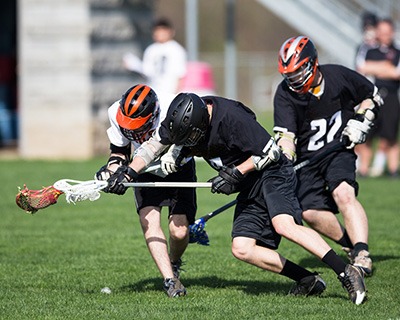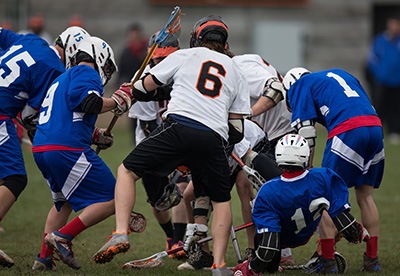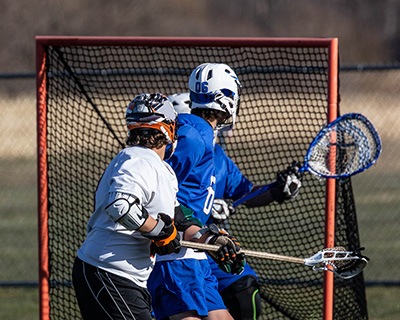If you're an aspiring lacrosse long-stick midfielder (LSM) or the proud possessor of a recent position switch, you know that there's one key factor: You've got to dominate.
LSM is one of the most physically demanding positions in lacrosse. It requires agility and intricate knowledge of both offensive and defensive strategies because, at times, your defense might sit back as your offense builds continuity, leaving only you as a last line of defense.
That said, mastering it calls for extra preparation—and implementing the following lacrosse LSM tips will help make sure all your hard work pays off!
More...
Take Away Key Points:
What Does LSM Stand for in Lacrosse?

Lacrosse is one of the most exciting sports to watch and play. The sport combines speed, agility, and strategic decision-making - all crucial elements lacrosse players need to be successful.
As lacrosse continues to gain popularity, those who support the game often use the term LSM when discussing lacrosse players. It stands for 'long stick midfielder', which refers to lacrosse players who specialize in playing defense while they hold a long stick with enlarged heads.
This specialized lacrosse player is tasked with disrupting passes, taking away shooting and passing lanes, protecting the goal area, and circulating the ball upfield for their team's offensive player line.
LSMs are critical for lacrosse teams because they can dramatically change a game's tempo and create scoring opportunities for their team by tackling or forcing turnovers.
What is the Job of Long Stick Middies?
The lacrosse player wearing the lacrosse stick with the long shaft is considered by many to be the most important lacrosse position: LSM (long-stick midfielder).
This player plays a crucial role in laying the foundation of an effective defensive game plan. As this is the first line of defense against the opposing team's offense, LSMs must pay attention around them and move quickly to intercept passes, fight through screens, and limit shot opportunities.
While playing, a good LSM defensive player handles a long stick, or a d-pole, while being prepared to assist other defenders and follow the ball once it crosses over to the offensive side of the field.
They may also need to support their short stick middies if their movement creates an open gap in the field.
Furthermore, they are often referred to as 'Ground Ball Masters,' where they are in charge of scooping up loose balls on the ground. With these roles, LSM must be smart and courageous during a lacrosse match. Their streaky performance will ultimately determine how successful or unsuccessful their lacrosse team can be.
How to Upgrade Your Long Stick Midfielder Game: Top LSM Tips
1. Be quick on your feet!
The primary role of an LSM in lacrosse is to disrupt the opposing team's offense. Therefore, LSMs are expected to be quick and agile, intercepting passes and taking away shooting lanes from their opponents.
To do this effectively, LSMs must pay attention around them and move quickly to intercept passes, fight through screens, and limit shot opportunities.
In the first place, LSM should possess good footwork. Footwork is essential for LSMs as it allows them to move quickly and change direction to keep up with their opponents. In addition, having a good footwork base will enable LSMs to be one step ahead of the opposing team and create turnovers, leading to scoring opportunities for their team.
To upgrade footwork, you can include these activities into your daily lifestyle:

With these simple yet effective steps regularly followed, lacrosse players can boost their LSM performance quickly!
2. Midfield defense: playing defense strategy
Playing team defense in lacrosse is a key way to give yourself an advantage on the field.
Learning how to slide as lacrosse players properly can help to establish a better line of communication between teammates and keep opponents from scoring an easy goal. It also opens up opportunities for turnovers and gives everyone on the team time to get into proper defensive positioning.
Lacrosse sliding requires that lacrosse players always be aware of their position on the field—looking out for which zones are open and closed, who is checking them near the goal, making sure lanes are covered—and having quick feet so they can swiftly switch positions when necessary.
A lacrosse slide is vital when playing defense. For example, if the other team burns your teammate, a player on the defensive slide should 'slide' and stop the opponent from hitting the goal.
It should not be done recklessly since it could be considered dangerous. Therefore, lacrosse players should practice sliding drills with coaches to learn proper techniques to successfully play effective team defense on the lacrosse field.
3. Master the stick skills
In addition to footwork, LSMs should also focus on their stick skills. Stick skills are essential for LSMs to disrupt passes from their opponents successfully. A good midfield defense player should have a quick release and be able to effectively steal the ball from their opponents.
Mastering all the skills with the stick as an LSM defender player isn't easy, but here are some tips to help:
4. Work on your Lacrosse IQ
As lacrosse players, developing lacrosse IQ skills will take our game to the next level.
To do this, there are a few key points that we need to remember if we want to be the best of the best at the midfield defense (LSM) position.
First, it is important to watch how others play. Try and recognize positioning habits other lacrosse players employ, both offensively and defensively, as they can be essential tools for you to utilize in gameplay.
Next, understand how all positions interact on the lacrosse field. By studying how successful lacrosse players coordinate their movements with those around them, you can learn how the entire team works together and elevate your gameplay.
Lastly, while instinctual lacrosse plays can be great moments of inspiration on the field, planning is a great way to prepare yourself for in-game scenarios fully. Lacrosse games are often won or lost based on split-second decisions; having a developed lacrosse IQ means making smart decisions ahead of time without hesitation.
With these tips in mind, lacrosse players can confidently operate within their long stick middies role using strategies that maximize results each time they step onto the lacrosse field!
5. Become a Master at ground balls
A good defense lacrosse player should be well-versed in handling ground balls. As a long-stick middle defense player (LSM), this skill is even more critical since these players are often tasked with quickly controlling the ball, transitioning it up the field, and getting possession faster than another team's best middie.
To successfully handle ground balls as an LSM, defenders should keep their sticks low and scoop beneath them both underneath and behind. Keeping the head of the lacrosse stick parallel to the ground will prevent any unnecessary ground balls from being kicked away from the player, which can result in a turnover or worse. Additionally, this will give you a better outlook to push the transition.
This is why it's necessary to master the stick skills first and be able to work with more than just a D-pole. Defenders should be able to scoop, catch and throw the ball, all while cradling! The ability is not easy to reach, but it is recommended to continue practicing and learning from your mistakes.
Additionally, when picking up a ground ball with only one hand on your lacrosse stick, keep that free hand away from your body for a little extra stability. This will ensure better control and steadiness for moving it up the field. Knowing good technique for handling ground balls is decisive and essential for success as an LSM lacrosse player.
FAQs
Who is the best LSM?
The best LSM player in lacrosse is Michael Ehrhardt. Ehrhardt impacts all the areas in the field, from the defensive side to the offensive side, and has mastered all the necessary skills for a good LSM player.
What makes a good lacrosse midfielder?

A good LSM (lacrosse midfielder) player should be agile, flexible, concentrated on the ball and the paste of the game, and have incredible endurance!
Can LSM play offense?
No, LSM players only play in the defensive end midfielder position.
What are the best LSM lacrosse sticks?
The best LSM lacrosse stick should be longer than the average lacrosse stick. You can find the best lacrosse sticks in our blog post here.
What are the best LSM lacrosse drills?
The best LSM lacrosse drills include fast footwork, excellent stick skills, mastering the ground balls, transition, and shooting.
How many LSM are on a lacrosse team?
Each lacrosse team is allowed four LSM players on the field.
What is the most athletic position in lacrosse?
The midfielder is the most athletic position in lacrosse, considering it requires the player to be on their feet the entire game, working with both the defense and offensive end.
How long should an LSM stick be?
An LSM stick needs to be at least 42-60 inches long.
Conclusion
Playing an LSM defender position requires excellent agility, smarts, and courage. In addition, it is not for the faint of heart, as LSMs have to defend against some of the best players in lacrosse.
With that being said, mastering this position can be incredibly rewarding - providing your team with much-needed defensive stops and allowing you to score goals. Still, it can also cause a lot of team pressure, so make sure you take the position with full confidence!
